Proposed sites to host inshore fisheries pilots 2017: consultation
Consultation seeking views on proposals for the Inshore Fisheries Pilot initiative.
Proposal 3 - Orkney Scallop Fishery
A brief summary of the proposal. Please see the proposal form for more detail ( http://www.gov.scot/Resource/0052/00525816.pdf )
Who has put forward the proposal
Orkney Fisheries Association ( OFA).
The area to which the proposal would apply
The Orkney RIFG area (as indicated in the diagram below).
Figure 16: Location of Orkney scallop management zone.
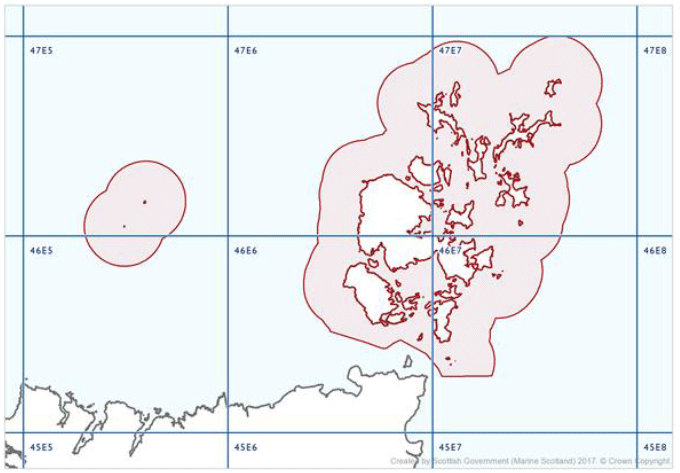
What changes would be brought into effect
The aim of the proposed pilot is to trial local management arrangements for scallops within 6 nautical miles (nm) of the Orkney Isles.
The management measures we seek views on are:
- A minimum landing size of 110 mm for king scallops landed into the Orkney Isles.
- Vessels fishing within 6 nm of the Orkney Isles cannot use more than a total of 10 dredges.
- Vessels of a length of 17 metres or more will not be permitted within 6 nm of the Orkney Isles.
- No vessel which is to be used to dredge for scallops may use or carry aboard more than two tow bars with a combined overall length - or a single tow bar or beam with an overall length including axles - of more than 6.20 metres, or more than a total of 10 scallop dredges or 2 x 4.4 metre beams within 6 nm of the Orkney Isles.
- A minimum landing size of 64 mm for queen scallops ( Aequipecten opercularis) landed into the Orkney Isles.
- Vessels over 12 metres, with AIS or other electronic systems, must have their systems switched on at all times while within 8 nm of the Orkney Isles.
Changes from original proposal
Marine Scotland has amended some of the proposed management measures as set out in the Orkney Fisheries Association proposal form.
Firstly, a proposal that:
- Vessels of a size normally rigged to carry more than 8 dredges per side and of a length of 17m or more will not be permitted inside 6nm of Orkney
Has been amended to a simple restriction on vessels over 17 metres in length, following discussions with the proposers. We believe this change provides greater clarity over eligibility whilst still achieving the proposers aim of restricting vessels over 17 metres.
Similarly, a provision that
- Vessels of a size and normally rigged for 8 dredges per side will be allowed to fish inside the management area but will be required to reduce their dredge numbers to 10 in total inside the management area.
Has been removed as this duplicates a proposal that
- Vessels fishing within 6 nm of the Orkney Isles cannot use more than a total of 10 dredges.
Where restrictions are proposed on the size of scallops that vessels can carry aboard this has been amended to landing size provisions.
- Vessels fishing inside 6 nm of Orkney will not carry aboard any Scallops less than 110 mm in size
- No vessel trawling for queen scallops inside Orkney waters will carry aboard queen scallops of less than 64 mm in size.
This is to make the proposals both consistent with current arrangements elsewhere in Scotland, and consistent with other parts of the proposal form which refer to restrictions based on landing size.
The expected benefits
The proposers believe that the above measures would:
- Relieving fishing pressure - less gear weight on the benthic environment - less intensity of fishing.
- Informing future management considerations of inshore fishing - continued data gathering benefits and costs of measures and practicalities of implementation.
- Increasing the protection of the environment or fish stocks.
- Give evidence of the economic or market benefits of managing fisheries in a different way - build evidence and management resilience for Marine Stewardship Council ( MSC) certification.
How changes will be monitored
The proposal suggests that:
- A monitoring group would be formed, comprising of representatives from participants in the pilot. This would include MS Compliance, MS Science, Orkney Sustainable Fisheries Ltd, and representatives of non-Orkney based fishing interests.
- A dedicated individual would monitor and record the progress of the pilot, taking information from all participants and reporting to the monitoring group.
Marine Scotland Estimation of Fishing Activity in the Area
Value of King Scallops Landed into Orkney
Figure 16 shows the total tonnage and value of king scallops landed into Orkney between 2011-16 (both dredged and dive caught). It shows higher values in 2015 and 2016, in terms of both tonnage and value landed, compared to 2011. Value has increased from under £800,000 in 2011 to nearly £1.2 million in 2016. During the period, 33 individual vessels recorded landings of king scallops into the area.
Figure 17: Value and tonnage of king scallops landed into Orkney, 2011-16.
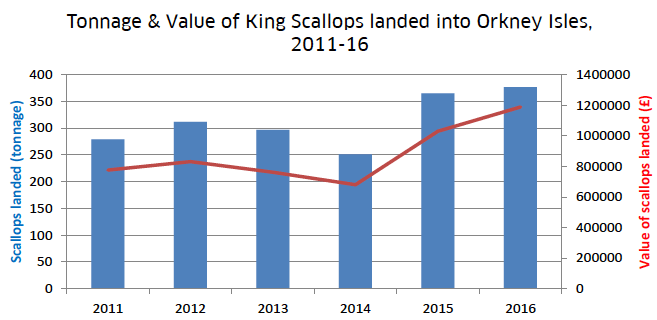
Value of scallops caught by vessels over 17 metres in length
Those most directly impacted by the proposal are those vessels over 17 metres in length that currently fish within 6 nm of the Orkney Isles. Using VMS data linked to landings from logbooks, it is possible to estimate the tonnage and value of landings from these vessels over recent years.
Figure 18: Estimated value and tonnage caught by vessels over 17 metres in length within 6 nautical miles of Orkney, 2011-16.
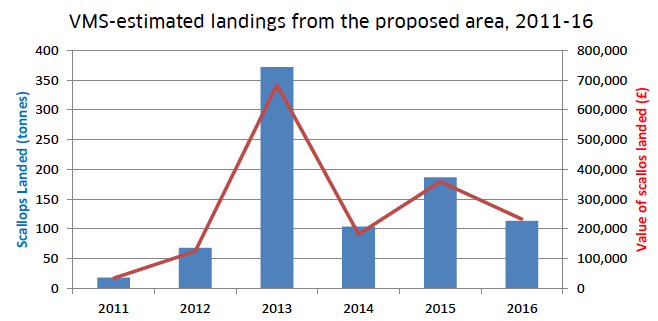
Nineteen individual vessels over 17 metres in length recorded landings from within 6 nm of Orkney during the period 2011-16. The tonnage and value landed by these vessels fluctuates without trend as shown in Figure 18, from a low of 17.5 tonnes in 2011 to over 370 tonnes (and a value of £700,000) in 2013.
To give an indication of the relative importance of catches from the area by these 19 vessels, the graph below shows the tonnage landed by these vessels within and out with the proposed area.
Figures 19: Estimated tonnage of scallops landed from proposed area and scallops landed elsewhere from vessels over 17 metres in length estimated to have had activity within the area, 2011-16.
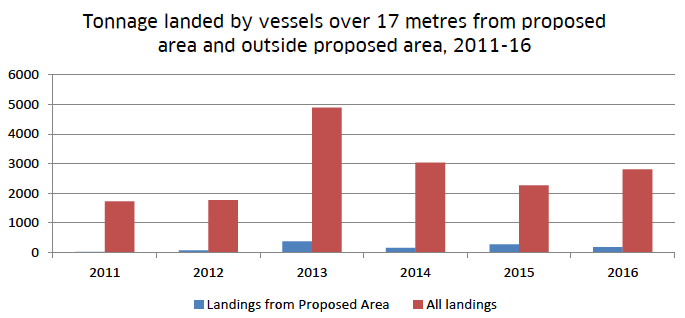
Value of Queen Scallops Landed into Orkney
Figure 20 shows the tonnage and value of queen scallops landed into Orkney from 2011-16. It can be seen that the tonnage and value of queen scallops landed into the Orkney Isles is considerably lower than king scallops. The tonnage caught increases from one tonne at the start of the period up to 40 tonnes in 2016.
Figure 20: Value and tonnage of queen scallops landed into Orkney, 2011-16.
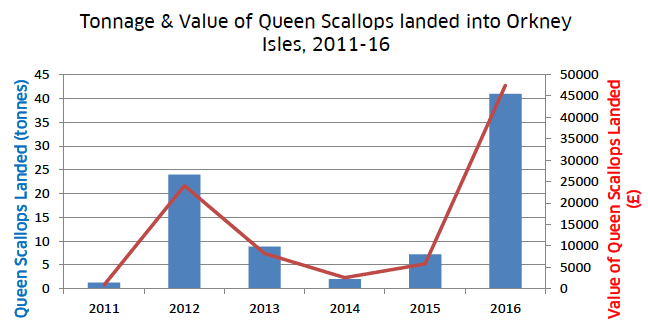
Impact of Dredge Restrictions
Records held by Marine Scotland on the number of dredges used by vessels are incomplete, especially in relation to smaller inshore vessels. However, where records are held, they indicate that all vessels that have fished within the proposed area in the period 2011-16 with more than 10 dredges are over 17 metres in length and would therefore be ineligible to fish on the basis of vessel length.
Impact of increasing the Minimum Landing Size of King Scallops
Following a public consultation [3] , Marine Scotland increased the minimum landing size of king scallops to 105 mm in those areas of the sea where the landing size had previously been 100 mm (with the exception of the Shetland Isles). This size increase came into force from 1 June 2017.
Some of the RIFGs, including Orkney, have requested that a larger landing size of 110 mm be introduced for their area. Marine Scotland has committed to reviewing the 105 mm increase two years after introduction, in order to assess its impact and whether a further increase to 110 mm be introduced. Should this inshore fisheries pilot be implemented, the minimum landing size of scallops for Orkney would be increased to 110 mm to coincide with the commencement of the pilot.
In terms of the impact of increasing the minimum landing size to 110 mm, an estimate based on Marine Scotland Science market sampling data calculates that around 4% of landings into Orkney are below 110 mm [4] .
Due to a lack of data, we are unable to estimate the impact of increasing the minimum landing size of queen scallop from the current legal minimum size of 45 mm to 64 mm.
Questions
6. Do you agree that the pilot proposal for the management of scallops around the Orkney Isles should be taken forward by Marine Scotland as described?
7. What is your view on the possible impact, both positive and negative, of the introduction of a minimum landing size of 110 mm for king scallops landed into the Orkney Isles?
8. What is your view on the possible impact, both positive and negative, of restricting vessels to no more than 10 dredges in total when fishing for scallops within 6 nautical miles of the Orkney Isles?
9. What is your view on the possible impact, both positive and negative, of prohibiting vessels of more than 17 metres from fishing within 6 nautical miles of the Orkney Isles?
10. What is your view on the possible impact, both positive and negative, of prohibiting vessels from using or carrying on-board more than two tow bars with a combined overall length, or a single tow bar or beam with an overall length of more than 6.20 metres, or more than a total of 10 scallop dredges or 2 x 4.4 metre beams within 6 nautical miles of the Orkney Isles?
11. What is your view on the possible impact, both positive and negative, of the introduction of a minimum landing size of 64 mm for queen scallops landed into the Orkney Isles?
12. What is your view on the possible impact, both positive and negative, of requiring that vessels over 12 metres in length, with AIS or other electronic systems, must have their systems switched on at all times while within 8 nautical miles of the Orkney Isles?
Contact
There is a problem
Thanks for your feedback